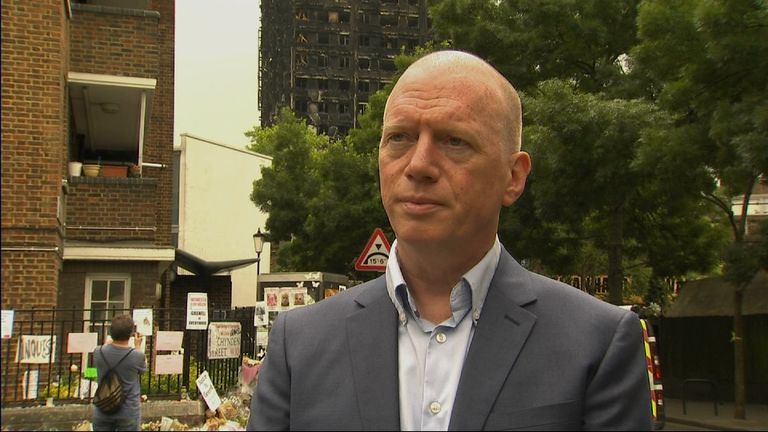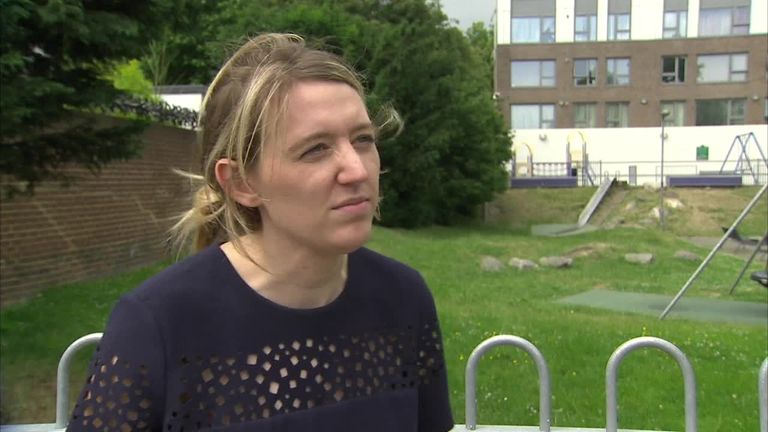Grenfell Tower fire: Safety instructions issued to local authorities for 'immediate' action
Councils have been given a list of fire safety instructions as they check housing stock for the same cladding as Grenfell Tower.
Thursday 22 June 2017 20:04, UK
Local authorities have been issued with a list of instructions which must be actioned "immediately" following the Grenfell Tower fire.
At least 79 people are dead, or missing, presumed dead, following the blaze in west London.
As homes across the country are checked for , the Permanent Secretary at the Communities Department, Melanie Dawes, has written to chief executives of local authorities and housing associations, detailing the procedure they should follow.
In her letter, Ms Dawes sets out the actions that must be taken if insulation within cladding "is unlikely to be compliant with the requirements" of current building regulations.
"These interim mitigating measures must immediately be implemented to ensure the safety of residents, pending replacement of the cladding," she said.
The measures include:
- Inform your local fire and rescue service fire safety/protection department. Failure to do so may put firefighters as well as residents at risk.
- Check that the fire risk assessment has been carried out within the previous 12 months and that the recommendations within the action plan of the assessment have been completed; also, confirm that there have been no material changes (to the building, the fire safety measures or the occupancy) that could, potentially, undermine the validity of the fire risk assessment. If no fire risk assessment has been carried out, you must immediately arrange for a fire risk assessment to be carried out by a competent person.
- Engage with residents to ensure they fully understand the emergency fire procedures in the building, particularly the meaning of "stay put". Ensure that fire procedure notices are accurate.
- Check that, at ground level, or on any balconies, there are no combustible materials (eg storage of refuse) in the vicinity of the cladding. Ensure that there are measures to prevent combustible materials in such locations (eg by temporary barriers or instructions to residents). Instruct residents that they must not have any barbecues on any balcony.
- Check that all flat entrance doors, and doors that open onto escape corridors and stairways, are fire-resisting and effectively self-closing against any resistance of a latch (or, for example, in the case of plant rooms or cupboards, are kept locked shut).
- Check all walls that separate flats, plant and store rooms etc from escape routes to ensure there are no obvious routes for fire or smoke spread (eg holes where services, such as pipes and cables, pass through walls).
- Check that any smoke control systems, including associated fire-detection systems, are operating correctly.
- Check all facilities provided for firefighters, including firefighting lifts and dry or wet rising mains. If you have ANY concerns you should contact your local fire and rescue service, who will, if they have not already done so, carry out an inspection to ensure functionality.
- Ensure that there is sufficient roadway access and hardstanding for firefighting vehicles attending incidents.
- Check that insulation or other materials that form the facade meet all relevant standards. If the building is protected by an automatic sprinkler system (or equivalent fire suppression system) you might not need to take any further interim measures before replacement of the cladding. If the building is not protected by a suitable suppression system you must consider the need for interim measures.
- Residents to be advised to ensure all smoke alarms are present and working in their flat; to report concerns about fire safety measures in the building (eg presence of combustible materials in escape routes) to their landlord, and understand the purpose of any interim measures begin taken.
- Closure of car parks in which a vehicle fire could impinge on cladding.
- Provision of a temporary communal fire alarm system, comprising smoke detectors in circulation areas and plant rooms, and fire detectors (possibly heat detectors, rather than smoke detectors) in conjunction with fire alarm sounders in each flat. This will enable the entire block to be evacuated simultaneously in the event of fire. This option is unlikely to be suitable for tall blocks, in which a large number of people would need to use escape routes at the same time. The system may comprise a wireless system, using radio to link devices.
- Provision of a fire watch by appropriately trained patrolling security officers/wardens.
- In the case of the most serious risk, consideration must be given to moving all residents out of the block until satisfactory remedial work has been done.




